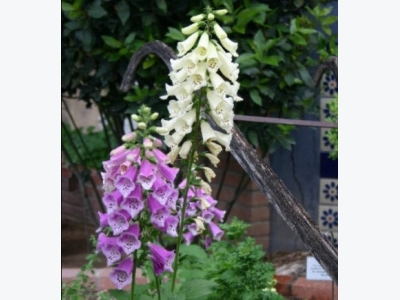How to Grow Foxglove (Digitalis)

If you dream of a romantic, old-fashioned garden, then foxgloves are sure to top your list. These plants produce spikes of bell-shaped flowers atop low mounds of foliage.
Foxgloves range in height from 3 to 5 feet and come in purple, pink, cream, yellow and red. They’re often combined with ferns, astilbes and other acid-loving plants. Most varieties are hardy in USDA Plant Hardiness Zones 4 through 9.
Foxglove leaves are highly toxic and should be used with care around children and pets. Interestingly, the toxic compounds, cardiac glycosides, have long been used to stimulate stronger heart palpitations in patients suffering heart failure.
Its name comes from the Old English, “foxes glofa.” A charming old myth says that foxes slipped the tubular flowers over their feet as gloves so they could creep undetected through the night to prey on a farmer’s chickens.
Growing Foxglove
To grow foxglove, sow them from seed in fall or spring, or install nursery plants after the last frost, spacing them up to 2 feet apart. Foxgloves thrive in moist, rich, slightly acidic soil and prefer partial shade. In cold climates, grow foxgloves with more sun. Amend the soil with compost and peat moss before planting.
Most foxglove varieties are biennials. This means if you plant foxglove from seed, they won’t produce flowers until the second year. The plants are usually short-lived, but they self-sow easily. Leave a few flowers to allow seeds to mature and drop. These seeds will produce new plants the following spring.
Keep the soil evenly moist after planting. Apply a two-inch layer of mulch once seedlings appear to conserve moisture and reduce weed growth. Fertilize foxglove in the spring before new growth appears with a balanced fertilizer, according to package directions.
Depending on the size of the plant, foxgloves may require staking, especially if you live in a windy climate. Insert bamboo or plastic stakes into the ground and secure the foxglove stalks to the stakes with soft bits of cotton fabric. Tie the fabric loosely to avoid damaging the plants.
To encourage abundant flowers, remove the central flower after it blooms. This will encourage side blooming. Foxgloves, with their dramatic spikes of blossoms, make wonderful cut flowers. Cut 12- to 18-inch stalks and arrange them with lilies, peonies and other cut flowers.
Dig up and divide foxglove plants every 2 years. This process keeps them tidy and may prolong their growth. Space the plants 12 to 15 inches apart.
Foxglove Problems and Pests
Most of the problems that afflict foxglove can be managed with proper care. Common diseases include powdery mildew, leaf spot and crown gall. To prevent these problems, space foxglove so air circulates freely between plants. Use drip irrigation, rather than overhead sprinklers to keep leaves dry and avoid working in the garden when it’s wet. Remove diseased leaves promptly and throw them away. Do not compost them.
Snails thrive in the partially shaded, moist conditions preferred by foxglove. You’ll recognize their damage by large jagged holes on the plants’ leaves. Install snail baits and traps or remove them and destroy them by hand.
Japanese beetles gnaw holes through both the leaves and flowers. These pests can quickly destroy your foxgloves. Japanese beetles are an invasive species found throughout the eastern United States. They are 1/2 an inch long with an iridescent green or gold back. To control them, handpick them and squash them or drop them in a bucket of soapy water. They fly slowly and are not difficult to catch. If you prefer, install bug bags. These bags have a pleasant floral scent that attracts the beetles. The beetles fly in the trap but can’t fly out. The one drawback to using the bags is that they attract beetles and not every beetle will go into the trap. Place the bags away from your foxgloves so you don’t create a larger problem.
Aphids appear in the spring. They don’t eat leaves, but damage plants by sucking the sap from the leaves and stems. They also leave a sticky, messy substance called honeydew. To control aphids, spray the undersides of the leaves with a stream of water. You can also apply insecticidal soap or insecticidal oils, which smothers the pests. Avoid using these products during hot, sunny weather and cover leaf surfaces completely.
Có thể bạn quan tâm
 How to Grow the Eastern Wahoo Shrub
How to Grow the Eastern Wahoo Shrub Flaming fall foliage and an attractive multi-stemmed form make Burning Bush a popular choice for a hedge or shrub planting.
 Secrets of Successful Container Gardening
Secrets of Successful Container Gardening Have you ever put together a really beautiful container garden, only to see some plants turn sickly and die after just a week or so?
 Growing Blazing Star (Liatris) Flowers: A How To Guide
Growing Blazing Star (Liatris) Flowers: A How To Guide Garden designers often recommend planting a combination of plants for the most pleasing effect in the garden.